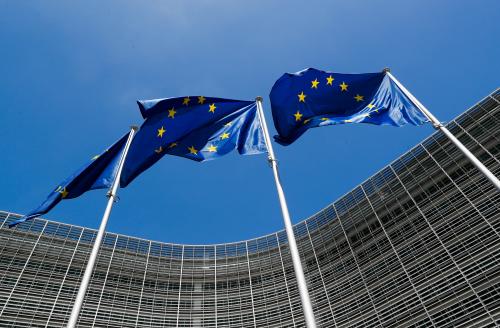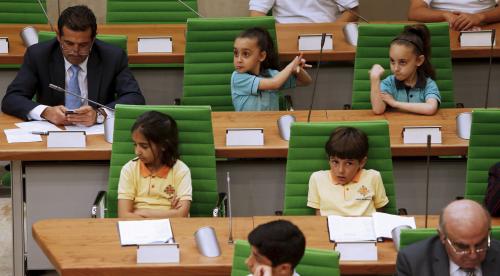The European Union’s economic engine is roaring after years of economic crisis and recession, with 2.4 percent GDP growth in 2017 and a promising near-term outlook. Even crisis-ridden Greece registered its first solid economic expansion in years. Most importantly, more people have jobs. Today, the number of persons employed in the EU is at a historic high and unemployment at the lowest level since 2009. Yet despite this good economic news, discontent and anxiety appear rife across the union as voters punish incumbent governments at almost every pass at the ballot box. What explains this seeming paradox?
Europe’s sustained post-crisis recovery has masked longstanding, but recently deepening, economic and social divides: Household income inequality has been on the rise in many parts of the EU since the 1990s, as low-income Europeans have been falling behind in the labor market—earnings of the poorest 10 percent of workers have actually declined since the 1980s. Productivity has been stagnant in Southern European member states since the early 2000s, widening the gap relative to its Northern neighbors. And regions within countries have seen divergence in living standards: Lagging regions in Southern European countries have seen no growth in GDP per capita since 2000, while regional inequality in GDP per capita has increased by 28 percent within Central and Southeast European countries—despite the strong convergence of these countries toward the EU average. The EU is growing, but not growing united.
These developments seemingly mark a break from the remarkable inclusive growth record of the EU’s “convergence machine,” which over the last 60 years has lifted the living standards of poorer countries, regions, and households in Europe.
What is behind these new divides? A new World Bank report on the European Union, Growing United: Upgrading Europe’s Convergence Machine, argues that in disrupting labor and product markets, technological change is driving a wedge through the EU, providing ever more opportunities for well-skilled workers and frontier firms, while leaving low-skilled workers and lagging firms behind. Automation, 3-D printing and artificial intelligence are changing the nature of Europe’s jobs, with a growing importance of non-routine, cognitive, and analytical tasks over more easily “automatable” routine manual tasks. Likewise, while technology helps Europe’s leading firms boost their productivity, failure to adopt new technologies is holding many firms back. As a result, productivity and wage gaps are widening.
Equality of opportunity for people and firms
The Growing United report proposes a simple framework to understand the growing divides based on the principle of equality of opportunity for people and firms. This principle, which is well established for people, applies equally well to firms, implying that the success of people and firms should be determined by talent, effort, and entrepreneurship—not by circumstances outside their control. The Figure 1 maps opportunities in each EU country along both dimensions, using widely accepted measures of opportunities for people and firms: skills and the business environment. To succeed in increasingly cognitive and fast-changing jobs, workers need proficiency in reading and mathematics as well as more advanced skills like problem-solving and social skills. However, significant numbers of youth across the EU struggle with text and numbers and enter the labor market unprepared for the uncertainties of the future of work. Likewise, the EU faces wide variations in business regulations and their enforcement, both between and within its member states. More burdensome business regulations make enterprises smaller, less productive, and less global, accentuating productivity gaps between countries and between regions as technological change accelerates.
Figure 1: The opportunities for firms and people to thrive determine the potential of countries to grow inclusively
Source: Calculations based on Program for International Student Assessment, Eurostat, and Doing Business data.
Note: The quality of the business environment is measured by the Doing Business 2017 distance to frontier index. Opportunities for people are measured by the percentage of students with basic competencies in the reading portion of the Program for International Student Assessment (PISA) in 2015, corrected for inequality of opportunity (variation in student basic reading competency explained by socioeconomic status), and the proportion of early school leavers (people aged 18–24 years old who only have lower secondary education or less and are no longer in education or training).
How are opportunities distributed across the EU? Our analysis reveals complementarity between opportunities for people and firms, with most countries situated along the bottom-left and top-right space. Northern European countries, Estonia and Poland are among the top opportunity performers: Most of their youth—including those from disadvantaged backgrounds—achieve basic competency in PISA reading, and their firms enjoy considerable economic freedom. Enterprises in Northern Europe and Germany also enjoy a supportive environment for innovation, making these economies productivity leaders. Meanwhile, many Southern and Central European countries are characterized by a high share of students below basic competency in reading—disproportionately from poor socioeconomic backgrounds—as well as more burdensome regulations and lower support for firm innovation.
The message from our analysis is that technological change is boosting inclusive growth in countries and regions that provide opportunities for skilled people and productive firms; however, it can equally be disruptive in places where opportunities are low, generating divergence.
Convergence Machine 2.0
What does it take for EU countries to translate economic growth into better living standards for all? The Growing United report argues that Europe’s convergence machine is due for an upgrade to keep up with technological change and seize its benefits for all Europeans. The “convergence machine 2.0” should focus on equalizing opportunities for people and firms across the union. We will explore its policy implications in a later blog post.








Commentary
Technological change and growing divides in Europe
March 30, 2018